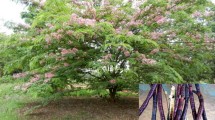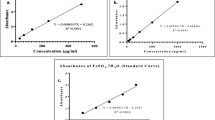Abstract
Zizyphus rugosa Lam (Z. rugosa Lam) (Family: Rhamnaceae), has been regarded as a food and medicinal plant. It is locally known as “Bon Boroi” or as “Jongli Boroi” in Bangladesh. Its stem, roots and fruits are used medicinally for the treatment of carbuncle, syphilis, menorrhea, and ulcer tongue. It is also used for dysentery in Laos, Burma, Thailand, China (Hainan, Yunnan), Sri-Lanka and Vietnam. The present study was designed to investigate antioxidant properties (through in vitro method) as well as brine shrimp lethality and phytochemical group evaluation of stem part of Z. rugosa Lam extracted with different solvents i.e. from non polar to polar (petroleum ether > ethyl acetate > ethanol > methanol > water). Phytochemical investigation showed the presence of alkaloids, flavonoid, glycosides and carbohydrates which provides evidence on good to moderate antioxidant and good lethality properties of the subjected plant. Ethyl acetate extract of stem was found to contain the highest amount of phenols (97.188 ± 12.816 mg/g gallic acid equivalent) and flavonoids (15.009 ± 0.385 mg/g quercetin equivalent). In 2,2-diphenyl,1-picrylhydrazyl (DPPH) free radical scavenging assay, among all the extracts ethanolic stem extract showed the highest scavenging property (IC50 83.550 µg/ml) whereas standard drug ascorbic acid showed (IC50 18.348 µg/ml). But in nitric oxide (NO) scavenging assay maximum scavenging of NO was found with water extract of stem (IC50 5.975 μg/ml) comparatively similar to standard ascorbic acid (IC50 5.934 μg/ml). Methanolic stem extract was found to contain the greater reducing power in reducing power capacity assessment (correlation coefficient r = 0.99 and P < 0.001). In brine shrimp lethality bioassay (BSLB) among all extracts, ZSM part showed good activity (LC50 40.43 μg/ml) whereas standard anticancer drug vincristine sulphate showed high toxicity (LC50 2.48 μg/ml). The overall findings provide scientific basis for the use of Z. rugosa Lam stem extracts in traditional medicine in the treatment of aforementioned diseases. Hence, the stem may serve as a new potential source of medication.

Similar content being viewed by others
References
W. Sneader, Drug prototypes and their exploitation (Wiley, UK., 1996)
J. Clardy, C. Walsh, Nature 432(7019), 829–837 (2004)
F.E. Koehn, G.T. Carter, Nat. Rev. Drug Discov. 4(3), 206–220 (2005)
M.S. Butler, Nat. Prod. Rep. 25, 475–516 (2008)
Ghani A. Medicinal Plants of Bangladesh. 2nd edn. (The Asiatic Society of Bangladesh. Dhaka, Bangladesh, 2003), pp. 31, 39-40, 418, 500-504, 589-580
K.R. Kirtikar, B.D. Basu, E. Blatter, J.F. Cains, K.S. Mhaskar, Indian medicinal plants, vol. 1 (Lalit Mohan Basu, Allahabad, India, 1975), p. 594
Dinesh Kumar Tyagi, Pharma forestry. Field guide to medicinal plants (Atlantic Publishers and Distributors, New Delhi, 2005), p. 147
A. Singh, M.B. Pandey, S. Singh, A.K. Singh, J.P. Singh, J. Indian Chem. Soc. 86(2), 177–178 (2009)
C.P. Khare, C.P. Khare, Indian medicinal plants: an illustrated dictionary (Springer Verlag, Berlin, 2007), p. 737
R.J.P. Cannel, How to approach the isolation of a natural product, in natural products isolation, 1st edn. (Humana Press, New Jersey, 1998), pp. 1–51
Y.S. Velioglu, G. Mazza, L. Gao, B.D. Oomah, J. Agric. Food Chem. 46, 4113–4117 (1998)
L. Yu, J. Agric. Food Chem. 49, 3452–3456 (2001)
S.Y. Wang, H. Jiao, J. Agric. Food Chem. 48, 5672–5676 (2000)
P. Prieto, M. Pineda, M. Aguilar, Anal. Biochem. 269, 337–341 (1999)
A. Braca, N.D. Tommasi, L.D. Bari, C. Pizza, M. Politi, I. Morelli, J. Nat. Prod. 64, 892–895 (2001)
R. Govindarajan, S. Rastogi, M. Vijayakumar, A. Shirwaikar, A.K.S. Rawat, S. Mehrotra, P. Palpu, Biol. Pharm. Bull. 26, 1424–1427 (2003)
M. Oyaizu, Jpn. J. Nutr. 44, 307–315 (1986)
A. Resat, G. Kubilay, O. Mustafa, E.K. Saliha, J. Agric. Food Chem. 52, 7970–7981 (2004)
Fazel Shami, Hamidreza Monsef, Rouhollah Ghamooshi, M. Verdian-Ariza, J. Pharma. Sci. 32 , 17-20 (2008)
B.N. Meyer, N.R. Ferrigni, J.E. Putnam, L.B. Jacobsen, Planta Med. 45, 31–34 (1982)
X.D. Luo, S.H. Wu, Y.B. Ma, D.G. Wu, Fitoterapia 71(5), 492–496 (2000)
J.L. Mclaughlin, J.E. Anderson, L.L. Rogers, Drug Info. J. 32, 513–524 (1998)
W.S. Abott, J. Am. Mosq. Control Assoc. 3(2), 302–303 (1987)
A. Yildirim, A. Mavi, M. Oktay, A.A. Kara, J. Agric. Food Chem. 48, 5030–5034 (2000)
Y.C. Tripathi, S.K. Maurye, V.P. Singh, V.B. Pandey, Phytochemistry 28(5), 1563 (1986)
V.B. Pandey, Y.C. Tripathi, S. Devi, J.P. Singh, A.H. Shah, Phytochemistry 27(6), 1915–1918 (1988)
Y.C. Tripathi, S. Devi, V.B. Pandey, A.H. Shah, Fitoterapia 59(2), 158 (1988)
V.B. Pandey, Y.C. Tripathi, Fitoterapia 64(4), 341–343 (1993)
C. Rice-Evans, N. Miller, G. Paganga, Trends Plant Sci. 2, 152–159 (1997)
J. Moline, I.F. Bukharovich, M.S. Wolff, Med. Hypoth. 55(4), 306–309 (2000)
Y. Arai, S. Wantanabe, M. Kimira, K. Shimoi, Am. Soc. Nutr. Sci. 130(9), 2243–2250 (2000)
G.G. Duthie, S.J. Duthei, J.A.M. Kyle, Nutr. Res. Rev. 13, 79–106 (2000)
W. Zheng, Y.S. Wang, J. Agric. Food Chem. 49, 5165–5170 (2001)
O. Benavente-Garcia, J. Castillo, F.R. Marin, A. Ortuño, J.A. Del-Rio, J. Agric. Food Chem. 45, 4505–4515 (1997)
M. Oktay, I. Gulcin, O.I. Kufrevioglu, LWT 36, 263–271 (2003)
M.E.H. Mazumder, S. Rahman, Pharm. Biol. 46(10), 704–709 (2008)
W. Brand-Willams, M.E. Cuvelier, C. Berset, LWT 28, 25–30 (1995)
J.C. Espin, C. Soler-Rivas, H.J. Wichers, J. Agric. Food Chem. 48, 648–656 (2000)
R.J. Ruch et al., Carcinogenesis 10, 1003–1008 (1989)
R. Radi, J.S. Beckman, K.M. Bush, B.A. Freeman, J. Biol. Chem. 266, 4244–4250 (1991)
S. Moncada, R.M. Palmer, E.A. Higgs, Pharmacol. Rev. 43, 109–142 (1991)
J.S. Beckman, T.W. Beckman, J. Chen, P.A. Marshall, B.A. Freeman, Proc. Nat. Acad. Sci. USA 87, 1620–1623 (1990)
K. Shimada, K. Fujukawa, K. Yahara, T. Nakamura, J. Agric, Food Chem. 40, 945–948 (1992)
M. Tanaka, C.W. Kuei, Y. Nagashima, T. Taguchi, Nippon Suisan Gakkaishi 54, 1409–1414 (1998)
B. Ozcelik, M. Kartal, I. Orhan, Pharm. Biol. 9(4), 396–402 (2011)
M.L. Dhar, M.N. Dhar, B.N. Dhawan, Ind. J. Expt. Biol. 11, 43–45 (1973)
P. Vijayan, V. Rreethi, S.H. Prashanth, H. Raghu, Biol. Pharm. Bull. 24, 528–530 (2004)
S. Badami, S.A. Manohara, E.P. Kumar, Phytother. Res. 17, 1001–1004 (2003)
C.C. Chang, M.H. Yang, H.M. Wen, J.C.J. Chern, Food Drug Anal. 10, 178–182 (2002)
Acknowledgments
We are greatly thankful to Laboratory of Natural Products Research (LNPR), Department of Pharmacy, Jahangirnagar University to provide sufficient laboratory facilities to carry out this research.
Author information
Authors and Affiliations
Corresponding author
Rights and permissions
About this article
Cite this article
Hossain, M.S., Uddin, N., Islam, A.F.M.M. et al. Evaluation of in vitro antioxidant and brine shrimp lethality activities of different stem extracts of Zizyphus rugosa Lam. Food Measure 9, 454–462 (2015). https://doi.org/10.1007/s11694-015-9253-4
Received:
Accepted:
Published:
Issue Date:
DOI: https://doi.org/10.1007/s11694-015-9253-4




